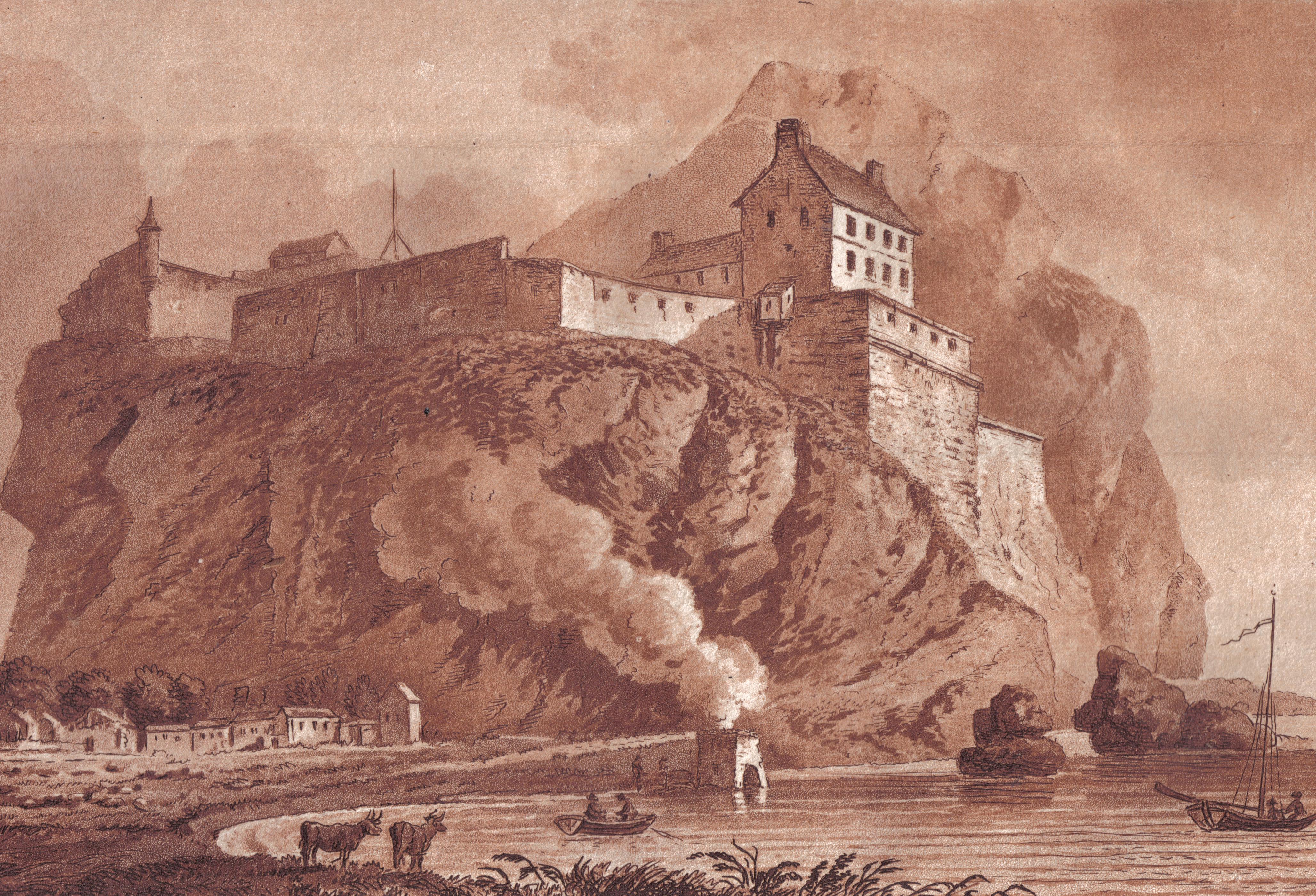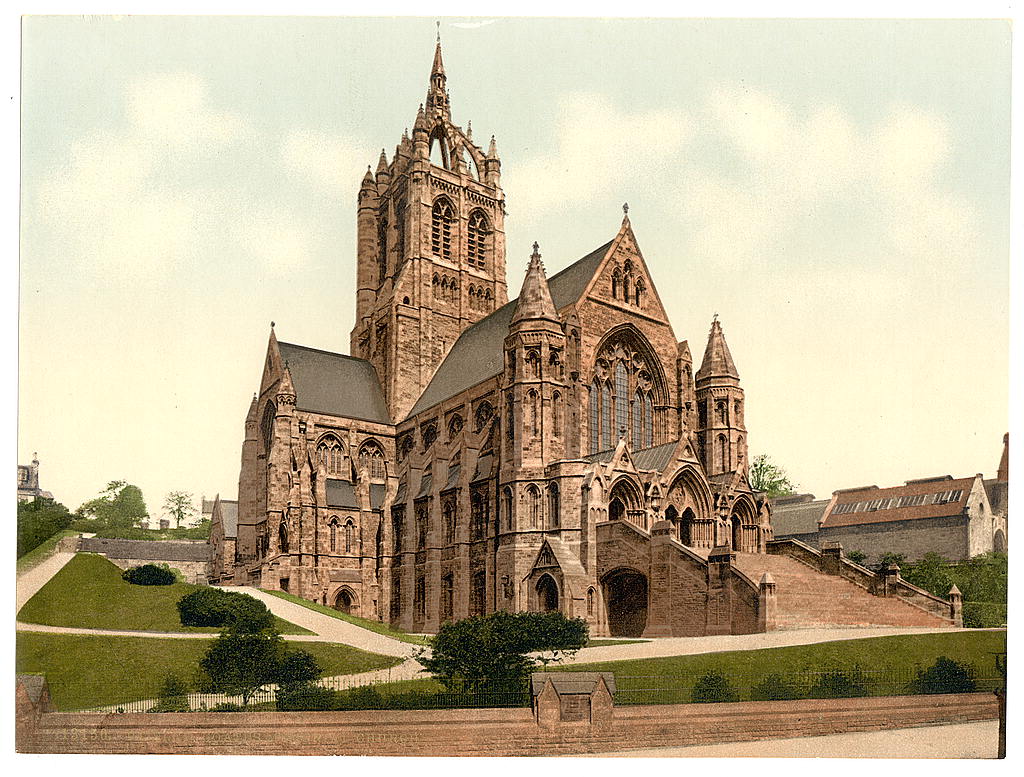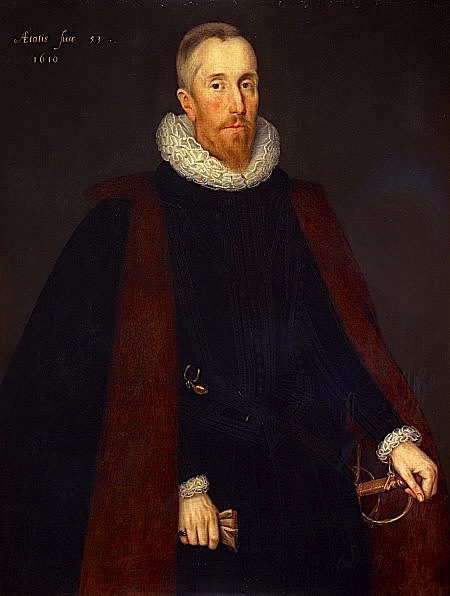|
Claud Hamilton Of Cochno
Claud Hamilton of Cochno was a Scottish landowner and Captain of Dumbarton Castle. He was a son of Andrew Hamilton of Cochno, captain of Dumbarton Castle and Margaret Noble. Andrew Hamilton's brother was the soldier Robert Hamilton of Briggis, Captain of Linlithgow Palace and Dunbar Castle. Cochno is in Faifley, and is known for the Cochno Stone. The family were supporters of Mary, Queen of Scots, and in 1568 Regent Moray and Lord Sempill took possession of the House of Cochno. His father died in 1573 and his older brother John Hamilton inherited, then after his death Cochno came to Claud Hamilton. He was also Captain of Dumbarton Castle from 1590 to 1596. In February 1597 he complained about a neighbour to the Privy Council. John Menteith in Lettir, whose father rented his lands from David Haldane, Tutor of Gleneagles, with other neighbours, had stolen oxen grazing on the Muir of Cochno which belonged to Claud Hamilton and his tenants. Alexander Seton, 1st Earl of Dunfermline ... [...More Info...] [...Related Items...] OR: [Wikipedia] [Google] [Baidu] |
Dumbarton Castle
Dumbarton Castle ( gd, Dùn Breatainn, ; ) has the longest recorded history of any stronghold in Scotland. It sits on a volcanic plug of basalt known as Dumbarton Rock which is high and overlooks the Scottish town of Dumbarton. History Dumbarton Rock was formed between 330 and 340 million years ago, during the Early Carboniferous period, a time of widespread volcanic activity in the area where Glasgow is now situated; over time, the softer exterior of the volcano weathered away, leaving behind a volcanic plug of basalt. Iron Age At least as far back as the Iron Age, this has been the site of a strategically important settlement, as evidenced by archaeological finds. The people that came to reside there in the era of Roman Britain were known to have traded with the Romans. However the first written record about a settlement there was in a letter that Saint Patrick wrote to King Ceretic of Alt Clut in the late 5th century. Early Medieval era David Nash Ford has proposed tha ... [...More Info...] [...Related Items...] OR: [Wikipedia] [Google] [Baidu] |
Gleneagles (Scotland)
Glen Eagles (Scottish Gaelic: Gleann na h-Eaglais/Gleann Eagas) is a glen which connects with Glen Devon to form a pass through the Ochil Hills of Perth and Kinross in Scotland. (The spelling as two words, 'Glen Eagles', is as shown on UK Ordnance Survey maps.) The name's origin has nothing to do with eagles, and is a corruption of ''eaglais'' or '' ecclesia'', meaning church, and refers to the chapel and well of Saint Mungo, which was restored as a memorial to the Haldane family which owns the Gleneagles estate. Gleneagles House at the northern entrance to Gleneagles comprises a 1750 extension to an earlier 17th-century building that is approached by an avenue of lime trees planted to commemorate the Battle of Camperdown. Little remains of Gleneagles Castle, the early 16th-century tower house of the Haldanes. The Caledonian Railway Company used its name for the Gleneagles Hotel and golf course they built some distance from the glen at the edge of Auchterarder. The h ... [...More Info...] [...Related Items...] OR: [Wikipedia] [Google] [Baidu] |
Archbishop Of Cashel
The Archbishop of Cashel ( ga, Ard-Easpag Chaiseal Mumhan) was an archiepiscopal title which took its name after the town of Cashel, County Tipperary in Ireland. Following the Reformation, there had been parallel apostolic successions to the title: one in the Church of Ireland and the other in the Roman Catholic Church. The archbishop of each denomination also held the title of Bishop of Emly. The Church of Ireland title was downgraded to a bishopric in 1838, and in the Roman Catholic Church it was superseded by the role of Archbishop of Cashel and Emly when the two dioceses were united in 2015. History Pre-Reformation In 1118, the metropolitan archbishoprics of Armagh and Cashel were established at the Synod of Ráth Breasail. The archbishop of Cashel had metropolitan jurisdiction over the southern half of Ireland, known as Leth Moga. At the Synod of Kells in 1152, the metropolitan see of Cashel lost territory on the creation of the metropolitan archbishoprics of Dublin a ... [...More Info...] [...Related Items...] OR: [Wikipedia] [Google] [Baidu] |
Paisley, Renfrewshire
Paisley ( ; sco, Paisley, gd, Pàislig ) is a large town situated in the west central Lowlands of Scotland. Located north of the Gleniffer Braes, the town borders the city of Glasgow to the east, and straddles the banks of the White Cart Water, a tributary of the River Clyde. Paisley serves as the administrative centre for the Renfrewshire council area, and is the largest town in the historic county of the same name. It is often cited as "Scotland's largest town" and is the fifth largest settlement in the country, although it does not have city status. The town became prominent in the 12th century, with the establishment of Paisley Abbey, an important religious hub which formerly had control over other local churches. By the 19th century, Paisley was a centre of the weaving industry, giving its name to the Paisley shawl and the Paisley pattern. The town's associations with political radicalism were highlighted by its involvement in the Radical War of 1820, with striking ... [...More Info...] [...Related Items...] OR: [Wikipedia] [Google] [Baidu] |
Archibald Hamilton (bishop)
Archibald Hamilton ( – 1659) was the fourth Anglican Archbishop of Cashel. Birth and origins Archibald was born about 1580 probably in Cochno, Dunbartonshire, Scotland, the second son of Claud Hamilton and his wife Margaret Betoun. His father was Laird of Cochno. His father's family was a cadet branch of the House of Hamilton founded by Walter fitz Gilbert of Cadzow. His mother was a daughter of Robert Betoun of Creich. Studies and marriages Hamilton studied at Glasgow University and obtained a MA in 1599. He stayed on, started teaching but also became minister in Paisley in 1610. He became a Doctor of Divinity (D.D.) in 1617. While still in Scotland he married his first wife, who probably was Alison Hay, who had been a nurse to Elizabeth, Queen of Bohemia. Later he married Anne Balfour of Burleigh, daughter of James Balfour, 1st Baron Balfour of Glenawley. He had four sons, and some of his descendants became established in the Swedish nobility. Career He was n ... [...More Info...] [...Related Items...] OR: [Wikipedia] [Google] [Baidu] |
Claud Hamilton Of The Fort Of Toome
Sir Claud Hamilton (died 1640) was constable of the Fort of Toome in County Antrim, Ulster, Ireland. He is sometimes confused with Claud Hamilton of Shawfield. Birth and origins Claud was the eldest son of Claud Hamilton and his wife Margaret Betoun. His father was Laird of Cochno (also spelled Cochnough) in Dunbartonshire in Scotland. Robert Hamilton of Briggis was a brother of his paternal grandfather. His father's family probably was a cadet branch of the House of Hamilton founded by Walter fitz Gilbert of Cadzow. Claud's mother was a daughter of Robert Betoun of Creich. He was the eldest of several brothers but only the first (himself) and the second are known: # Claud (died 1640) # Archibald ( – 1659), Anglican Archbishop of Cashel Homonym friend Hamilton was a friend of his homonym Sir Claud Hamilton of Shawfield with whom he is sometimes confused. He was present at his friend's deathbed in Dublin on 19 October 1614. First marriage ... [...More Info...] [...Related Items...] OR: [Wikipedia] [Google] [Baidu] |
Creich Castle
Creich Castle is a ruined tower house near Creich, Fife, Scotland. The tower house and its associated buildings is a scheduled monument. There is a mention of a castle on the property in the 13th century, but it is uncertain what relationship that has to the existing structures. There is documentary evidence of a tower in 1553, but the existing structure either postdates that or has been heavily remodeled, judging by its architectural style. History The first surviving records that mention Craich show that it was held by the MacDuff, Earls of Fife and they were probably the builders of the first Creich Castle. The land was subsequently owned by the Liddel family until they forfeited it when charged with treason. The Beaton family purchased it in 1503 and the property has been linked with David Betoun of Creich, Cardinal David Beaton, a 16th century Archbishop of St Andrews, and Mary Bethune. The existing ruins date from the 16th century. Description The castle is south of ... [...More Info...] [...Related Items...] OR: [Wikipedia] [Google] [Baidu] |
Alexander Seton, 1st Earl Of Dunfermline
Alexander Seton, 1st Earl of Dunfermline (1555–1622) was a Scottish lawyer, judge and politician. He served as Lord President of the Court of Session from 1598 to 1604, Lord Chancellor of Scotland from 1604 to 1622 and as a Lord High Commissioner to the Parliament of Scotland. Early life Born at Seton Palace, East Lothian, he was the son of George Seton, 7th Lord Seton, and Isobell Hamilton. The Setons remained a Roman Catholic family after the Scottish Reformation of 1560, and continued to support Mary, Queen of Scots, after her abdication and exile in England. Alexander Seton was educated at the German and Roman College in Rome from June 1571 to December 1578. Alexander was noted learning Italian and science (philosophy) in Rome by Baptista da Trento in 1577 in a letter describing plots to marry Elizabeth I of England to the Earl of Leicester and re-instate Mary in Scotland. The family historian Viscount Kingston heard that he was skilled in mathematics, heraldry and arch ... [...More Info...] [...Related Items...] OR: [Wikipedia] [Google] [Baidu] |
David Masson
David Mather Masson LLD DLitt (2 December 18226 October 1907), was a Scottish academic, supporter of women's suffrage, literary critic and historian. Biography He was born in Aberdeen, the son of William Masson, a stone-cutter, and his wife Sarah Mather. David was educated at Aberdeen Grammar School under Dr. James Melvin and at Marischal College, University of Aberdeen. Intending to enter the Church, he proceeded to Edinburgh University, where he studied theology under Dr. Thomas Chalmers, with whom he remained friendly until the latter's death in 1847. However, abandoning his aspirations to the ministry, be returned to Aberdeen to undertake the editorship of the ''Banner'', a weekly paper devoted to the advocacy of Free Kirk principles. After two years he resigned this post and went back to Edinburgh to pursue a purely literary career. There he wrote a great deal, contributing to ''Fraser's Magazine'', ''Dublin University Magazine'' (in which appeared his essays on Tho ... [...More Info...] [...Related Items...] OR: [Wikipedia] [Google] [Baidu] |
Clan Haldane
Clan Haldane is a Lowland Scottish clan.Way, George and Squire, Romily. ''Collins Scottish Clan & Family Encyclopedia''. (Foreword by The Rt Hon. The Earl of Elgin KT, Convenor, The Standing Council of Scottish Chiefs). Published in 1994. Pages 158 - 159. History Origins of the clan Bernard, son of Brien, received from William the Lion the manor of Hauden between 1165 and 1171. A cadet of the house is believed to have settled in Strathearn and acquired lands which later became part of the barony of Gleneagles, where the chiefs of Clan Haldane still reside today. The name Gleneagles has nothing to do with the chief's heraldry but is derived from the Scottish Gaelic, ''eaglais'', which means ''a church''. Wars of Scottish Independence In 1296 Aylmer Haldane appears in the Ragman Rolls swearing fealty to Edward I of England. However he soon allied himself with Robert the Bruce in the struggle for Scottish independence. In 1312 Sir Simon Haldane received a charter for part of the ... [...More Info...] [...Related Items...] OR: [Wikipedia] [Google] [Baidu] |
Robert Hamilton Of Briggis
Robert Hamilton of Briggis (died 1568) was a Scottish soldier and military engineer. He was keeper of Linlithgow Palace and Dunbar Castle and was Master of the Scottish artillery. Lands Briggis was an estate at Kirkliston near the Almond Water a West Lothian river and the Gogar Burn. The ancient monument called the Cat Stane is on this ground. Hamilton held the lands of Easter Briggis from Lord Torphichen, not directly from the crown, and so was sometimes called "Robert Hamilton ''in'' Briggis". In 1561 Hamilton was exempted fom paying teinds. Robert Hamilton also gained lands at Easter Collessie or Halhill in Fife. He was a brother of Andrew Hamilton of Cochno, governor of Dumbarton Castle. Career In February 1542 James V of Scotland sent Robert Hamilton and Matthew Hamilton of Milnburn to France. They were allowed to return by Regent Arran in January 1543. On 22 August 1543 he was made Keeper and Captain of Linlithgow Palace, with its gardens, tennis court, and eel-trap ... [...More Info...] [...Related Items...] OR: [Wikipedia] [Google] [Baidu] |
Privy Council Of Scotland
The Privy Council of Scotland ( — 1 May 1708) was a body that advised the Scottish monarch. In the range of its functions the council was often more important than the Estates in the running the country. Its registers include a wide range of material on the political, administrative, economic and social affairs of the Kingdom of Scotland. The council supervised the administration of the law, regulated trade and shipping, took emergency measures against the plague, granted licences to travel, administered oaths of allegiance, banished beggars and gypsies, dealt with witches, recusants, Covenanters and Jacobites and tackled the problem of lawlessness in the Highlands and the Borders. History Like the Parliament, the council was a development of the King's Council. The King's Council, or ''curia regis'', was the court of the monarch surrounded by his royal officers and others upon whom he relied for advice. It is known to have existed in the thirteenth century, if not earlier, ... [...More Info...] [...Related Items...] OR: [Wikipedia] [Google] [Baidu] |






